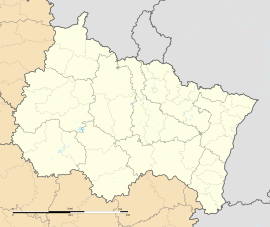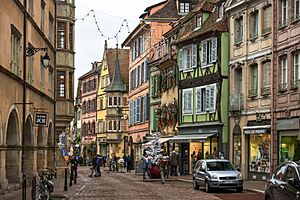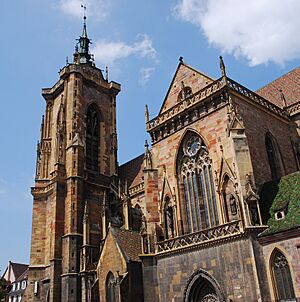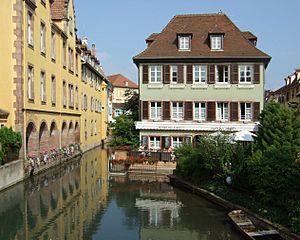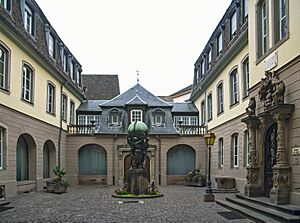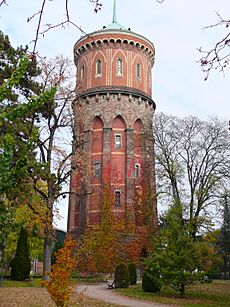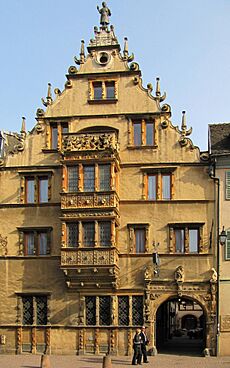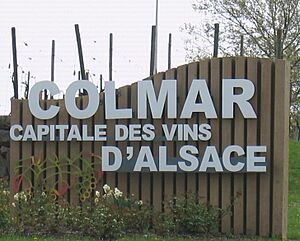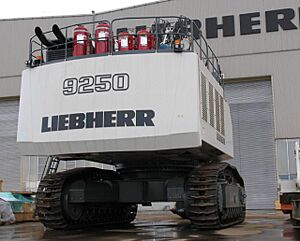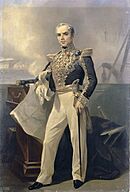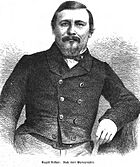Colmar facts for kids
Quick facts for kids
Colmar
|
|||
|---|---|---|---|
|
Prefecture and commune
|
|||

Colmar's "Little Venice"
|
|||
|
|||
| Country | France | ||
| Region | Grand Est | ||
| Department | Haut-Rhin | ||
| Arrondissement | Colmar-Ribeauvillé | ||
| Canton | Colmar-1 and 2 | ||
| Intercommunality | Colmar Agglomération | ||
| Area
1
|
66.57 km2 (25.70 sq mi) | ||
| Population
(2021)
|
67,730 | ||
| • Density | 1,017.43/km2 (2,635.1/sq mi) | ||
| Time zone | UTC+01:00 (CET) | ||
| • Summer (DST) | UTC+02:00 (CEST) | ||
| INSEE/Postal code |
68066 /68000
|
||
| Dialling codes | 0389 | ||
| Elevation | 175–214 m (574–702 ft) (avg. 197 m or 646 ft) |
||
| 1 French Land Register data, which excludes lakes, ponds, glaciers > 1 km2 (0.386 sq mi or 247 acres) and river estuaries. | |||
Colmar is a charming city in north-eastern France. It is located in the Haut-Rhin area of the Alsace region. Colmar is the third-largest city in Alsace. It is known for its beautiful old town and many historic buildings.
The city is also famous for its museums. One of the most important is the Unterlinden Museum. It holds a very famous artwork called the Isenheim Altarpiece. Colmar is also on the Alsatian Wine Route. It is often called the capital of Alsatian wine.
Contents
Colmar's History
|
Imperial City of Colmar
|
|||||||
|---|---|---|---|---|---|---|---|
| 1226–1679 | |||||||
| Status | Imperial City | ||||||
| Capital | Colmar | ||||||
| Common languages | Alsatian | ||||||
| Government | City-state | ||||||
| Historical era | Middle Ages | ||||||
|
• Immediacy granted by Frederick II
|
1226 | ||||||
|
• Joined Décapole
|
1354 | ||||||
| 1673 | |||||||
|
• Ceded at Nijmegen
|
1679 | ||||||
|
|||||||
Colmar was first mentioned a very long time ago. This was in a record by Charlemagne in 884. In 1226, Colmar became a free imperial city. This meant it was directly under the Holy Roman Emperor.
In 1354, Colmar joined a group of ten cities called the Décapole. This was a league for protection and trade. The city became Protestant in 1575. During the Thirty Years' War, Swedish armies took control of Colmar for two years.
France, under King Louis XIV, took over Colmar in 1673. It officially became part of France in 1679. Later, in 1871, Colmar became part of Germany after a war. It returned to France after World War I in 1919.
During World War II, Nazi Germany took control of Colmar again in 1940. But it returned to France after a battle in 1945. Colmar has been led by conservative parties since 1947.
In 1863, a special collection of valuable items was found in Colmar. It was called the Colmar Treasure. Jewish people had hidden it during the time of the Black Death.
Colmar's Location and Climate
Where is Colmar?
Colmar is about 64 kilometers (40 miles) south of Strasbourg. It sits on the River Lauch, which flows into the Ill river. The city is just east of the Vosges mountains. A canal connects it to the Rhine river.
In 2017, Colmar had about 69,105 people living there. The larger area around Colmar had about 199,234 people in 2018. Colmar is the main city of the arrondissement of Colmar-Ribeauvillé.
Colmar's Weather
Colmar has a special kind of weather. It has cold, dry winters and warm, wet summers. This is because it is far from the ocean.
The city has a very sunny microclimate. It is one of the driest cities in France. It gets only about 607 millimeters (24 inches) of rain each year. This dry, sunny weather is perfect for making Alsace wine. That's why Colmar is called the capital of the Alsatian wine region.
The mountains nearby cause this dry weather. Clouds coming from the west drop most of their rain over the mountains. By the time the air reaches Colmar, it is much drier and warmer.
| Town | Sunshine (hours/yr) |
Rain (mm/yr) |
Snow (days/yr) |
Storm (days/yr) |
Fog (days/yr) |
|---|---|---|---|---|---|
| National average | 1,973 | 770 | 14 | 22 | 40 |
| Colmar | 1,780.7 | 606.6 | 25.7 | 24.8 | 55.4 |
| Paris | 1,661 | 637 | 12 | 18 | 10 |
| Nice | 2,724 | 767 | 1 | 29 | 1 |
| Strasbourg | 1,693 | 665 | 29 | 29 | 56 |
| Brest | 1,605 | 1,211 | 7 | 12 | 75 |
| Climate data for Colmar (1981–2010 averages, extremes 1957−present) | |||||||||||||
|---|---|---|---|---|---|---|---|---|---|---|---|---|---|
| Month | Jan | Feb | Mar | Apr | May | Jun | Jul | Aug | Sep | Oct | Nov | Dec | Year |
| Record high °C (°F) | 18.5 (65.3) |
22.7 (72.9) |
27.3 (81.1) |
29.7 (85.5) |
34.7 (94.5) |
38.6 (101.5) |
38.7 (101.7) |
40.9 (105.6) |
33.7 (92.7) |
30.7 (87.3) |
24.0 (75.2) |
20.3 (68.5) |
40.9 (105.6) |
| Mean daily maximum °C (°F) | 4.8 (40.6) |
6.8 (44.2) |
11.9 (53.4) |
16.0 (60.8) |
20.4 (68.7) |
23.7 (74.7) |
26.1 (79.0) |
25.8 (78.4) |
21.4 (70.5) |
15.8 (60.4) |
9.2 (48.6) |
5.5 (41.9) |
15.7 (60.3) |
| Daily mean °C (°F) | 1.7 (35.1) |
2.8 (37.0) |
6.9 (44.4) |
10.4 (50.7) |
14.9 (58.8) |
18.0 (64.4) |
20.2 (68.4) |
19.7 (67.5) |
15.8 (60.4) |
11.3 (52.3) |
5.7 (42.3) |
2.7 (36.9) |
10.9 (51.6) |
| Mean daily minimum °C (°F) | −1.4 (29.5) |
−1.2 (29.8) |
2.0 (35.6) |
4.8 (40.6) |
9.3 (48.7) |
12.3 (54.1) |
14.2 (57.6) |
13.7 (56.7) |
10.2 (50.4) |
6.8 (44.2) |
2.2 (36.0) |
−0.2 (31.6) |
6.1 (43.0) |
| Record low °C (°F) | −22.0 (−7.6) |
−24.8 (−12.6) |
−16.0 (3.2) |
−7.3 (18.9) |
−3.1 (26.4) |
2.1 (35.8) |
4.0 (39.2) |
3.2 (37.8) |
−1.0 (30.2) |
−7.6 (18.3) |
−13.1 (8.4) |
−19.0 (−2.2) |
−24.8 (−12.6) |
| Average precipitation mm (inches) | 31.7 (1.25) |
28.8 (1.13) |
37.4 (1.47) |
44.7 (1.76) |
74.2 (2.92) |
64.2 (2.53) |
66.8 (2.63) |
57.0 (2.24) |
57.8 (2.28) |
56.9 (2.24) |
40.1 (1.58) |
47.7 (1.88) |
607.3 (23.91) |
| Average precipitation days (≥ 1 mm) | 7.1 | 7.0 | 8.5 | 8.9 | 11.2 | 9.6 | 9.4 | 9.1 | 7.9 | 9.3 | 7.3 | 8.5 | 103.9 |
| Average snowy days | 7.0 | 6.2 | 3.6 | 1.1 | 0.0 | 0.0 | 0.0 | 0.0 | 0.0 | 0.0 | 2.7 | 5.1 | 25.7 |
| Average relative humidity (%) | 87 | 82 | 76 | 74 | 75 | 72 | 69 | 72 | 76 | 83 | 87 | 88 | 78.4 |
| Mean monthly sunshine hours | 71.8 | 97.0 | 144.7 | 180.2 | 201.5 | 225.5 | 239.2 | 223.6 | 170.7 | 116.9 | 70.5 | 57.5 | 1,799 |
| Source 1: Météo France | |||||||||||||
| Source 2: Infoclimat.fr (humidity and snowy days, 1961–1990) | |||||||||||||
Population Over Time
| Historical population | |||||||||||||||||||||||||||||||||||||||||||||||||||||||||||||||||||||||||||||||||||||||||||||||||||||||||||||||||||
|---|---|---|---|---|---|---|---|---|---|---|---|---|---|---|---|---|---|---|---|---|---|---|---|---|---|---|---|---|---|---|---|---|---|---|---|---|---|---|---|---|---|---|---|---|---|---|---|---|---|---|---|---|---|---|---|---|---|---|---|---|---|---|---|---|---|---|---|---|---|---|---|---|---|---|---|---|---|---|---|---|---|---|---|---|---|---|---|---|---|---|---|---|---|---|---|---|---|---|---|---|---|---|---|---|---|---|---|---|---|---|---|---|---|---|---|
|
|
||||||||||||||||||||||||||||||||||||||||||||||||||||||||||||||||||||||||||||||||||||||||||||||||||||||||||||||||||
| Source: EHESS and INSEE (1968-2017) | |||||||||||||||||||||||||||||||||||||||||||||||||||||||||||||||||||||||||||||||||||||||||||||||||||||||||||||||||||
Things to See in Colmar
Colmar's old town is very well preserved. It was mostly saved from damage during wars. This makes it a popular place for tourists. An area with canals is called "Little Venice". It used to be where butchers, tanners, and fishmongers worked.
Amazing Buildings
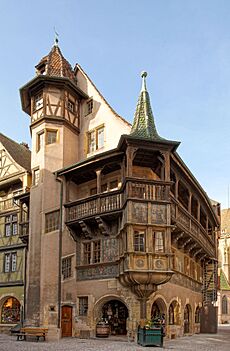
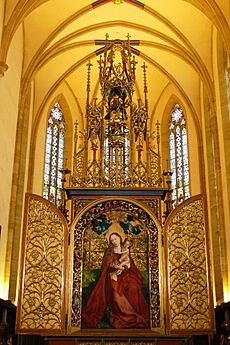
Colmar has many interesting buildings. They show styles from German and French architecture over 800 years. They use local materials like pink and yellow Vosges sandstone.
Historic Secular Buildings
- Maison Adolph – From the 14th century, in German Gothic style.
- Koïfhus – Built in 1480, a German Gothic building.
- Maison Pfister – From 1537, a beautiful German Renaissance house.
- Maison des Têtes – Built in 1609, another German Renaissance building.
- Marché couvert – The city's covered market from 1865. It's made of stone, bricks, and cast iron. It is still used today.
- Water tower – From 1886, the oldest preserved water tower in Alsace.
Religious Buildings
- Église Saint-Martin – Built between 1234 and 1365. It is the largest church in Colmar. It has old stained glass windows and Gothic sculptures.
- Église des Dominicains – Built between 1289 and 1364. It holds Martin Schongauer's famous painting, Madonna of the Rose Bower.
- Église Saint-Matthieu – From the 13th century. It has Gothic stained glass and painted ceilings.
- Couvent des Antonins – From the 13th century. It has a beautiful cloister. Now it is part of the Unterlinden Museum.
- Synagogue – Built in 1843 in a classic style.
Fountains and Monuments
- Fontaine de l'Amiral Bruat – From 1864, with a statue by Bartholdi.
- Fontaine Schwendi – From 1898, also with a statue by Bartholdi.
- Monument du Général Rapp – From 1856, one of Bartholdi's first big works.
- Statue of Liberty replica – A smaller copy of the famous statue in New York.
Colmar's Museums

- Unterlinden Museum – This is one of the most important museums in Alsace. It has the famous Isenheim Altarpiece. It also shows many old paintings, sculptures, and ancient items.
- Musée Bartholdi – This museum is in the house where Frédéric Auguste Bartholdi was born. He was the sculptor who created the Statue of Liberty. The museum shows his life and works.
- Musée d'histoire naturelle et d'ethnographie – This museum has a large collection of stuffed animals. It also has items from Africa and Polynesia, and ancient Egypt.
- Musée du jouet – This is the town's toy museum, opened in 1993.
- Choco-Story Colmar – A museum about the history of chocolate. You can taste different chocolates here.
Colmar's Library
The Municipal Library of Colmar has one of the largest collections of very old printed books (called incunabula) in France. It has over 2,300 of these rare books. This is special because Colmar is not a main university city. Many of these books came from local monasteries and convents during the French Revolution.
Getting Around Colmar
Colmar has a small regional airport. The main railway station, Gare de Colmar, connects the city to places like Strasbourg, Mulhouse, and Zürich. There used to be a railway bridge to Freiburg in Germany, but it was destroyed in 1945.
Education in Colmar
Colmar has several senior high schools, including:
- Lycée Bartholdi
- Lycée Camille Sée
Colmar also shares the Université de Haute-Alsace (Upper Alsace University) with the city of Mulhouse. About 1,500 students study at the Colmar campus.
Music in Colmar
Since 1980, Colmar has hosted an international summer festival of classical music. It is known as the Festival de Colmar. Famous conductors like Vladimir Spivakov have led the festival.
Colmar's Economy
Colmar is a wealthy city. Its main strength is its busy tourism industry. Many people visit to see its beauty. It is also home to several large companies. These include Timken and Liebherr.
Every year since 1947, Colmar hosts a big event. It is called the Foire aux vins d'Alsace (Alsatian wine fair). This is the largest festival and commercial event in Alsace.
Parks and Fun in Colmar
In 1991, a Japanese boarding high school created a Japanese cultural center in Kientzheim, near Colmar. It had books and hosted events.
Famous People from Colmar
Many notable people were born or lived in Colmar, including:
- Martin Schongauer (1450–1491), a famous painter and engraver.
- Jean Rapp (1771–1821), a lieutenant general.
- Armand Joseph Bruat (1796–1855), an admiral.
- Frédéric Auguste Bartholdi (1834–1904), the sculptor who created the Statue of Liberty.
- Pierre Hermé (born 1961), a famous pastry chef.
- Cendrine Wolf (born 1969), a children's author.
Colmar's Sister Cities
Colmar is twinned with several cities around the world. This means they have special friendly relationships.
 Schongau, Bavaria, Germany (1962)
Schongau, Bavaria, Germany (1962) Lucca, Italy (1962)
Lucca, Italy (1962) Princeton, United States (1986)
Princeton, United States (1986) Győr, Hungary (1993)
Győr, Hungary (1993) Sint-Niklaas, Belgium (1962)
Sint-Niklaas, Belgium (1962) Vale of White Horse, England, United Kingdom (1978)
Vale of White Horse, England, United Kingdom (1978) Eisenstadt, Austria (1983)
Eisenstadt, Austria (1983)
Colmar in Malaysia
There is a resort in Bukit Tinggi, Malaysia called Colmar Tropicale. It is designed to look like the original Colmar in France. It is about 60 km (37 miles) north-east of Kuala Lumpur.
Nearby, there is also a rebuilt version of the Château du Haut-Kœnigsbourg. This castle is also found in the Alsace region of France.
See also
 In Spanish: Colmar para niños
In Spanish: Colmar para niños





